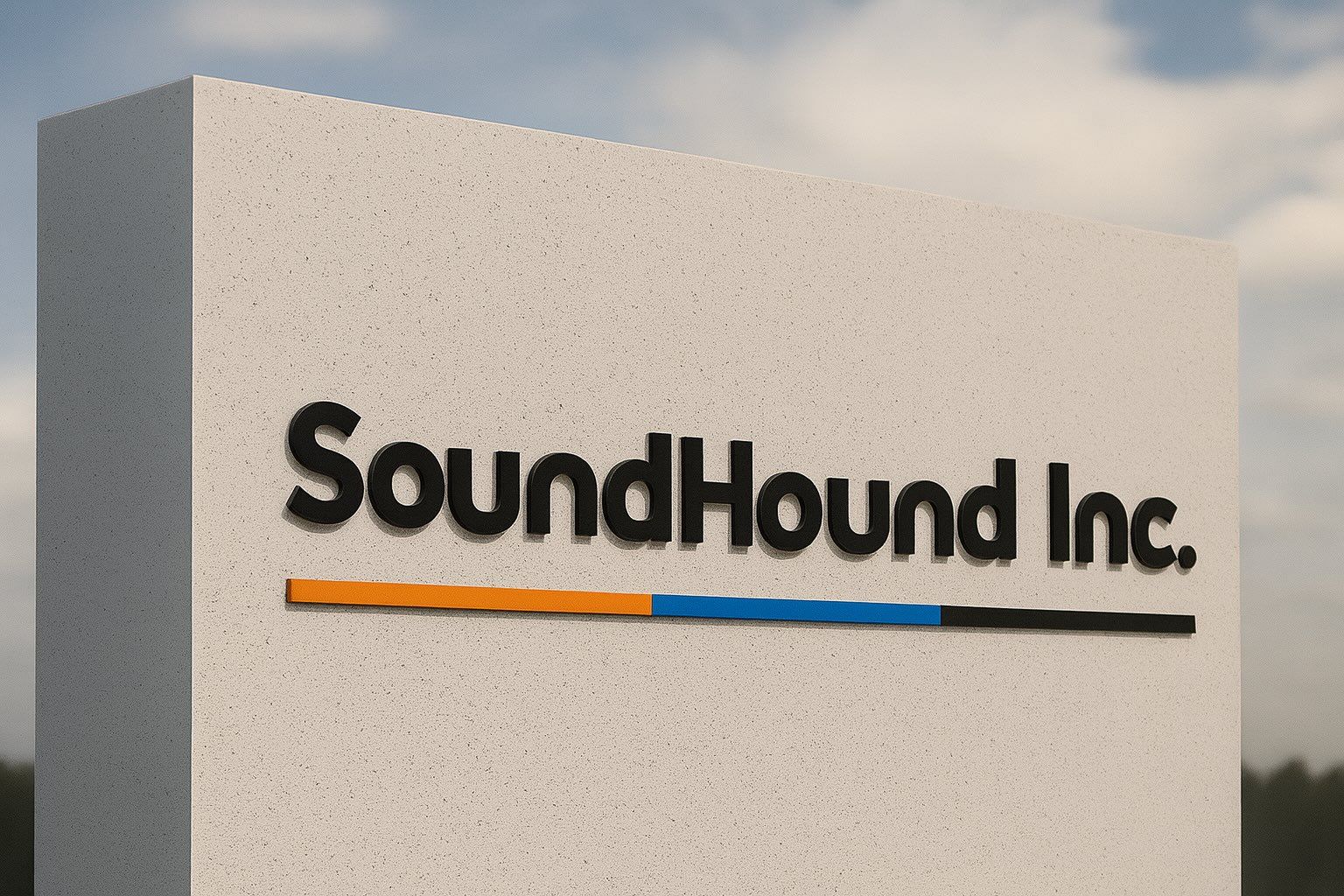- Explosive rally: SoundHound AI (NASDAQ: SOUN) has seen its stock price surge around 240% over the past year, recently jumping to about $20–21 per share – its highest levels since early 2025 [1] [2]. Heavy trading volume accompanied the rise (76+ million shares on Oct 14 alone, ~60% above average) [3], reflecting frenzied investor interest.
- Market cap & volatility: At ~$20 per share, SoundHound’s market capitalization now tops $8 billion, a stunning valuation for a still-unprofitable company [4] [5]. The stock’s 52-week range spans roughly $4.8 to $25 [6], underscoring extreme volatility – daily swings of 5–10% (or more) have not been uncommon. Short interest remains high (~30% of the float) [7], suggesting that some traders are betting against the stock even as others pile in, fueling a potential short squeeze rally.
- Recent catalysts: A flurry of positive news has ignited the recent run. Q2 2025 earnings (reported Aug 7) showed record revenue $42.7 million (+217% YoY) – beating analyst forecasts by ~30% [8] – and the company raised its full-year sales guidance. In late September, industry research firm IDC named SoundHound a leader in conversational AI, boosting credibility [9] [10]. New partnership wins (like a nationwide Red Lobster rollout for AI phone ordering) have also validated SoundHound’s technology [11].
- Soaring sales but losses ongoing: SoundHound’s revenue is doubling annually and management now projects $160–178 million in 2025 sales (nearly 2× 2024’s revenue) [12]. However, the company remains unprofitable – it posted a Q2 net loss of $0.19 per share (GAAP) despite a much smaller $0.03 loss on a non-GAAP basis [13]. Gross margins have been dampened (39% GAAP in Q2) by recent acquisitions, though on an adjusted basis margins are healthier (~58%) [14]. SoundHound’s leadership aims to reach breakeven by late 2025 as scale improves [15].
- Solid cash and $1B+ backlog: The firm’s balance sheet is strong, with about $230 million in cash and no debt (as of mid-2025) [16]. Importantly, SoundHound reports a customer contract backlog over $1.2 billion – more than 7× its current annual revenue [17]. This huge backlog (comprised of multi-year subscription and licensing deals) underscores robust demand in the pipeline. It also fueled an acquisition: in September, SoundHound spent $60 million in cash to acquire Interactions, a customer-service AI provider, to bolster its product offerings [18].
- Voice-AI leader with big partnerships: SoundHound has transformed from its music-recognition roots into a B2B voice AI platform powering restaurants, automakers, banks, and more. Its tech now handles drive-thru orders and call center queries. For example, a recent deal will deploy SoundHound’s AI to all Red Lobster locations to automate phone orders [19], after wins with chains like Chipotle and Applebee’s. In the auto sector, SoundHound’s voice assistant is embedded in Hyundai, Kia, and Stellantis vehicles via multi-year partnerships [20]. A new alliance with French insurer Apivia will use SoundHound’s latest AI agent in contact centers [21]. These partnerships validate the company’s technology and broaden its reach.
- Cutting-edge AI technology: SoundHound’s proprietary voice AI engine (“Speech-to-Meaning”) and its new Polaris speech model are touted as more accurate than big-tech rivals. In internal tests, Polaris is 30–40% more accurate at transcribing speech than OpenAI’s Whisper or Google’s voice AI [22]. The platform leverages generative AI too – its Amelia 7 assistant (launched May 2025) can “listen, reason, and act” to handle complex tasks end-to-end [23]. SoundHound’s voice assistants integrate large language models (like ChatGPT) to carry on natural, multi-turn conversations. This technological edge earned SoundHound recognition as an IDC MarketScape leader in conversational AI in 2025 [24].
- Lofty valuation raising eyebrows: Even fans admit SoundHound’s stock price has run far ahead of fundamentals. At ~$20/share, it trades at an extremely rich ~40–50× trailing sales [25] (and about 25× forward revenue) – valuations reminiscent of early-stage cloud software darlings. Bulls argue such a premium is justified by SoundHound’s triple-digit growth and strategic position as a pure-play AI innovator with a massive backlog [26]. Bears counter that competition from tech giants (Google, Amazon, Apple, etc.) and the long road to profitability make the stock vulnerable [27]. Notably, company insiders have taken some profits: over the last quarter insiders (including the CEO) sold about 725,000 shares (~$12.7 million worth) as the stock surged [28] [29]. Still, insiders and early investors retain significant stakes, and only ~19% of shares are held by institutions [30] – meaning retail traders dominate and contribute to the stock’s wild price swings.
- Analyst sentiment mixed: Wall Street’s verdict on SOUN is cautiously optimistic. According to MarketBeat, the stock has a consensus “Moderate Buy” rating [31], with roughly 5 Buy ratings, 4 Holds, and 1 Sell in recent months [32]. However, the average 12-month price target is only around $14–15 [33] [34] – well below the current price, implying that many analysts see the stock as overextended near term. In just the last few weeks, some firms raised their targets (e.g. Ladenburg Thalmann to $16; D.A. Davidson to $17) after SoundHound’s strong Q2 results and acquisition news [35]. Oppenheimer initiated coverage at “Perform” (neutral), praising SoundHound’s tech advantages and “durable growth potential” but warning of formidable competition ahead [36] [37]. On the bearish side, independent rater Weiss recently reiterated a Sell (D-) rating [38], and Zacks Investment Research continues to rank SoundHound a Hold, noting the company “has struggled to achieve profitability” despite rapid growth [39] [40].
- Short-term outlook: In the near term, market momentum and hype around AI could continue to propel SoundHound’s stock. A recent analysis on MarketBeat noted multiple catalysts – from general AI enthusiasm to new customer deals – that could keep the rally alive, and projected that Q3 2025 revenues may beat expectations given the large backlog of orders already in hand [41]. Technical traders observe that after breaking out above ~$18, the stock has little overhead resistance before last year’s highs (~$25) [42]. If AI-related stocks remain hot, SOUN could see further upside in the coming weeks. However, the risk of a pullback is also elevated. The same MarketBeat piece cautioned that with the stock now trading around 30× sales, any disappointment – whether a growth hiccup or broader market rotation – could trigger a sharp sell-off [43]. The sizable short interest could either exacerbate a squeeze or accelerate a decline if sentiment turns.
- Long-term prospects: Looking further ahead, SoundHound AI’s future will hinge on execution. The company is targeting a massive voice-AI market (estimated $50+ billion) for smart assistants across industries [44]. If SoundHound can convert its $1B+ backlog into sustainable revenue and continue growing 50–100% annually, many believe it could grow into its valuation over time. As one analyst observed, “the AI boom has put SoundHound on the radar as a potential long-term winner” in voice technology [45]. The firm’s niche focus – offering flexible, independent voice AI solutions to businesses – could carve out a lasting competitive edge, especially in domains like automotive, hospitality, and finance that value data privacy and customization. Conversely, skeptics argue that as Big Tech refines its own AI assistants, smaller players like SoundHound will face an uphill battle to maintain technical superiority. The company must also eventually prove it can turn its surging sales into real profits. For now, SoundHound AI’s stock embodies both the promise and the peril of the AI revolution: it’s riding a wave of excitement and extraordinary growth [46], but investors will be watching closely to see if this high-flying stock can deliver on its bold ambitions – or if gravity will soon take hold.
Sources: Official SoundHound financial releases [47] [48]; SoundHound press announcements (partnerships, product launches) [49] [50]; TechStock² (TS2) analysis and market data [51] [52]; MarketBeat and analyst reports [53] [54]; IDC and industry research on conversational AI [55].
References
1. ts2.tech, 2. ts2.tech, 3. www.marketbeat.com, 4. ts2.tech, 5. www.marketbeat.com, 6. ts2.tech, 7. ts2.tech, 8. ts2.tech, 9. ts2.tech, 10. ts2.tech, 11. ts2.tech, 12. ts2.tech, 13. ts2.tech, 14. ts2.tech, 15. ts2.tech, 16. ts2.tech, 17. ts2.tech, 18. ts2.tech, 19. ts2.tech, 20. ts2.tech, 21. ts2.tech, 22. ts2.tech, 23. ts2.tech, 24. ts2.tech, 25. ts2.tech, 26. ts2.tech, 27. ts2.tech, 28. www.marketbeat.com, 29. www.marketbeat.com, 30. www.marketbeat.com, 31. www.marketbeat.com, 32. www.marketbeat.com, 33. ts2.tech, 34. www.marketbeat.com, 35. ts2.tech, 36. ts2.tech, 37. ts2.tech, 38. www.marketbeat.com, 39. ts2.tech, 40. ts2.tech, 41. ts2.tech, 42. ts2.tech, 43. ts2.tech, 44. ts2.tech, 45. ts2.tech, 46. ts2.tech, 47. investors.soundhound.com, 48. ts2.tech, 49. ts2.tech, 50. ts2.tech, 51. ts2.tech, 52. ts2.tech, 53. www.marketbeat.com, 54. ts2.tech, 55. ts2.tech








